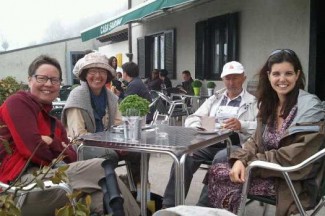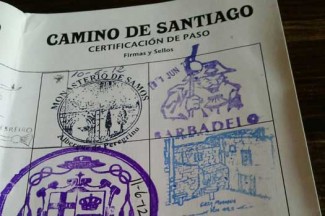
When the movie was released in November, my mother and I went to see it. “Was there anything that surprised you?” she asked as we walked out of the theater.
“No, I pretty much knew all that stuff,” I told her. I had, after all, been researching for my upcoming walk on the Camino for the last six months. I had read every book our library had on the topic. I knew about the passport stamps, the difficulties of sleeping in albergues, the variety of people I would meet. I also knew it was highly unlikely my pack would get stolen or fall in a river.
After seeing the movie, I found my fear of the Camino becoming inundated with Americans also disappeared. Harry Potter fans might plan a trip to Scotland to see where the films were made, but taking a month to walk nearly 500 miles took a bit more planning and physical stamina and was probably not the ideal vacation for most Americans.
It wasn’t until after friends started seeing The Way, however, that I realized what a gift it was. They no longer thought I was hiking something akin to the Appalachian Trail — camping out each night and cooking food over a campfire. They called, texted, and e-mailed their excitement after viewing the movie. “I watched The Way last night. Cried and laughed and put the Camino on my list,” Caitlin wrote to me on Facebook.
Walking the real thing

By far, the most popular sentiment was that the movie didn’t show enough of the physical difficulties many pilgrims experience. We never saw Martin Sheen treating his blisters — which nearly every pilgrim has at one point. There was no morning ritual of treating his feet with creams and powders — a common scene in most albergues shortly after pilgrims rise from their bunks and hobble around packing their bags.
“It looked like he just picked up that pack and walked off without any problems,” pilgrims told me. Most men over 60 who attempt the Camino without any training are going to do a little more huffing and puffing. Nor did we see any of the characters tossing items from their pack to lighten the load — another common occurrence in the early stages of the Camino.
But the movie wasn’t created to show exactly what it’s like to walk the Camino. It was a movie about relationships — the relationships between families, between strangers, with ourselves. And that part was true to the real life Camino. Most of us start alone. We all have people we’re leaving behind to go on this journey. We have our reasons for walking this ancient path. We meet people along the way. We open up to these strangers. We share our pasts, our thoughts, our fears, our dreams. These strangers become like family to us. We share meals, conversations, and blister remedies. They see us in good moods and bad. They celebrate with us when we reach our common destination. We part as friends, knowing that this experience was better having been shared with them.
______________________________________
Today I invite you to take time to thank the people that share with you on your daily “journey” — those that walk beside you, that listen to you, that advise you, that share life’s joys and sorrows with you.




